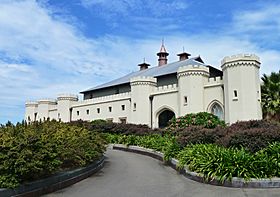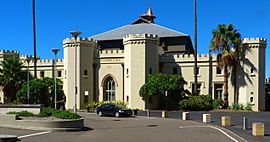Sydney Conservatorium of Music facts for kids

Sydney Conservatorium of Music, as viewed from the Royal Botanic Gardens
|
|
|
Other name
|
The Con |
|---|---|
|
Former name
|
New South Wales State Conservatorium of Music |
| Type | Public university college |
| Established | 1915 |
| Founders |
|
|
Parent institution
|
University of Sydney |
|
Academic affiliation
|
|
| Head of School and Dean | Anna Reid |
| Students | 1000 |
| Location |
,
,
Australia
33°51′48″S 151°12′52″E / 33.863455°S 151.214353°E |
 |
|
|
Building details
|
|

The facade of the Greenway-designed building
|
|
| Former names | Stables for the First Government House |
| General information | |
| Status | Complete |
| Architectural style | Gothic Picturesque |
| Construction started | 9 August 1817 |
| Completed | 1820 |
| Client | Colonial Governor |
| Design and construction | |
| Architect |
|
| Renovating team | |
| Architect | Chris Johnson |
| Renovating firm | NSW Government Architect with Daryl Jackson, Robin Dyke and Robert Tanner |
| Official name | Conservatorium of Music; Government House Stables; Governor's Stables |
| Type | State heritage (built) |
| Criteria | a., b., c., d., e., f., g. |
| Designated | 14 January 2011 |
| Reference no. | 1849 |
| Type | Stables |
| Category | Government and Administration |
The Sydney Conservatorium of Music (SCM), also known as "The Con", is a famous music school. It is part of the University of Sydney. It was started in 1915 by a Belgian conductor named Henri Verbrugghen. It is one of Australia's oldest and most respected music schools.
The main building, called the Greenway Building, is a heritage-listed site. It is located near the Royal Botanic Gardens in Sydney. The Conservatorium also has classes at the main University of Sydney campus.
The Greenway Building is home to the Conservatorium Open Academy and the Conservatorium High School. The Conservatorium teaches music to high school students, university students, and adults. It also does research in different areas of music. The building was added to the New South Wales State Heritage Register in 2011.
Contents
History of the Conservatorium
Early Days and the Greenway Building
The land where the Conservatorium stands originally belonged to the Aboriginal people. The "Eora" people, including the Cadigal and Wangal bands, lived around Sydney Harbour. They used the land's natural resources for food and shelter.
In 1788, Governor Arthur Phillip arrived and set up the first Government House. Later, Governor Lachlan Macquarie took over in 1810. He found the Government House and its stables in very bad condition. He wanted to build new, better buildings.
In 1817, Governor Macquarie asked Francis Greenway, a former convict who was an architect, to design new stables. Work on these stables began on August 9, 1817. Macquarie laid the foundation stone on December 16, 1817.
Greenway designed the stables in a "Gothic" style, like an old castle. It was sometimes called a "palace for horses" because it was so grand. The stables were finished in 1821. The cost of building them was one reason Governor Macquarie was later called back to Britain. This building is the only Gothic-style building designed by Greenway that is still standing today.
From Stables to Music School
After Macquarie left, the stables were used for different things. They were even considered as a possible new Government House. However, they remained largely unused for many years.
By 1910, cars were becoming more common, and the building was no longer needed for horses. In 1912, the government decided to turn the building into a music school. From 1913 to 1915, the building was changed to become the Conservatorium. A large auditorium was built inside the courtyard.
The Conservatorium officially opened on April 6, 1915. Henri Verbrugghen became the first director on May 20, 1915, and teaching started on March 6, 1916. The school aimed to provide music education as good as the best schools in Europe. The Conservatorium High School was also started in 1919.
Verbrugghen was a very energetic leader. He helped create Australia's first full-time orchestra, made up of both professional musicians and students. This orchestra was Sydney's main orchestra for much of the 1920s.
Growth and Modern Changes
Under later directors like Edgar Bainton (1934–48) and Sir Eugene Aynsley Goossens (1948–55), the Conservatorium's opera school became very important. Goossens helped make the Conservatorium a world-class music school.
In the 1970s, under Rex Hobcroft, the Conservatorium grew even more. It started offering different music studies, including classical, jazz, music education, and composition.
In 1990, the Conservatorium joined the University of Sydney and was renamed the Sydney Conservatorium of Music.
In 1997, the government announced a major upgrade for the Conservatorium. The goal was to create one of the best music education facilities in the world. The new design, finished in 2001, included underground rooms. Special building techniques were used to make sure the music inside was not disturbed by noise from nearby roads and trains. This project won an award for urban design in 2002.
Centenary Celebrations
To celebrate its 100th birthday in 2015, the Conservatorium asked composers to create 101 new pieces of music. This project aimed to honor the people who have shaped music over the past century.
Leadership
The Conservatorium has had many important leaders over the years:
| Name | Title | Term start | Term end |
|---|---|---|---|
| Henri Verbrugghen | Director | 1916 | 1921 |
| W. Arundel Orchard | 1923 | 1934 | |
| Edgar Bainton | 1934 | 1948 | |
| Sir Eugene Goossens | 1948 | 1955 | |
| Sir Bernard Heinze | 1957 | 1966 | |
| Joseph Post | 1966 | 1971 | |
| Rex Hobcroft | 1972 | 1982 | |
| John Painter | 1982 | 1985 | |
| John Hopkins | 1986 | 1991 | |
| Ronald Smart | Principal | 1992 | 1994 |
| Ros Pesman | Acting Principal | 1994 | 1995 |
| Sharman Pretty | Principal and Dean | 1995 | 2003 |
| Professor Kim Walker | Dean & Principal | 2004 | 2011 |
| Karl Kramer | 2012 | 2015 | |
| Professor Anna Reid | Head of School and Dean | 2015 | incumbent |
Students' Association
Students at the Conservatorium have their own group called the Conservatorium Students' Association. It was started in 1919. This group helps with student life and organizes events like the annual "Con Ball."
The Association has a Common Room and offices in the Greenway Building. They also sell Conservatorium merchandise. Elections for the student leaders happen every October.
Famous People from the Conservatorium
Many talented musicians and artists have studied at the Sydney Conservatorium of Music. Some of them include:
- Essie Ackland, singer
- Richard Bonynge, conductor
- Iva Davies, from the band Icehouse
- Tania Davis, from the band Bond
- David Hansen, singer
- Erin Holland, Miss World Australia 2013
- James Morrison, trumpet player
- Sam Moran, former member of The Wiggles
- Geoffrey Parsons, piano player
- Richard Tognetti, violin player
- Timmy Trumpet, DJ and producer
- Roger Woodward, piano player
- Simone Young, conductor
Notable Teachers
The Conservatorium has also had many famous teachers, including:
- Ole Bøhn, violin
- Ross Edwards, composition
- Isador Goodman, piano
- Matthew Hindson, composition
- Liza Lim, composition
- Robert Pikler, violin and viola
- Kathryn Selby, chamber music
- Alexander Sverjensky, piano
- Carl Vine, composition
- Wanda Wiłkomirska, violin
- Gerard Willems, piano
The Greenway Building Today
The Conservatorium of Music is a large building with a unique "Gothic Picturesque" style. It was originally built as stables for the Governor's horses. The architect, Francis Greenway, designed it to look like a castle with towers and battlements. Governor Macquarie wanted Sydney to be a beautiful city, and these stables were part of his grand plan.
The building is made of stone with rendered walls. It has towers at the corners and pointed arch doorways. The windows are also designed in a Gothic style.
Inside, the building used to have rooms around a central courtyard. This courtyard was later covered with a roof between 1913 and 1915 to create the Verbrugghen Hall, a large auditorium. The building still has its original layout with rooms around a central corridor.
In 2001, new basement levels were added. A new entrance connects the old stables building to these new areas. During these renovations, old roads and even the foundations of an old mill and bakery from the 1790s were found. Some of these old discoveries are now displayed in the Conservatorium.
Building Condition and Changes
Even though the building has been changed to fit a music school, much of its original structure is still there. It still looks like the old Gothic building it was designed to be.
Over the years, the building has had several changes:
- A large awning was added to the west side between 1913-1915, but it was removed in 2001.
- Windows and doors have been changed or rebuilt.
- The Conservatorium was expanded with new basement rooms and a new entrance in 2001.
- The Verbrugghen Hall was updated in 2001.
- Extensive digging for the 2001 extensions also helped archaeologists learn more about the site's history.
Heritage Listing
The Conservatorium of Music is very important to the history of New South Wales. It is a great example of "Old Colonial Gothick" architecture. It is also the only Gothic building designed by Francis Greenway that is still standing. Greenway played a key role in Governor Macquarie's plan to make Sydney an organized and stylish city. The high cost of the stables was one reason Macquarie was called back to Britain.
The building is also connected to Governor Macquarie's wife, Elizabeth, who helped shape the colony's style.
Since 1916, when it became a music school, the Conservatorium has been the main place for music education in New South Wales. Many important musicians have been part of its history.
The Sydney Conservatorium of Music was listed on the New South Wales State Heritage Register in 2011 because:
- It shows how Sydney developed and how Governor Macquarie wanted to make it a well-designed city.
- It is strongly linked to important people like Governor Macquarie, his wife Elizabeth, and architect Francis Greenway. It also has ties to famous musicians and directors like Henri Verbrugghen.
- It is a beautiful example of the "Old Colonial Gothick Picturesque" style, showing great creative and technical skill. Its large size and castle-like look made it a landmark.
- It is important to the community because it has been a center for music in New South Wales for generations.
- It has the potential to reveal more information about the early history of New South Wales through archaeological finds.
- It is rare because it is the only surviving Gothic building by Francis Greenway and one of the few stable blocks from Macquarie's time left in Sydney.
- It shows the main features of the "Old Colonial Gothic Picturesque" architectural style.
Images for kids
See also
 In Spanish: Conservatorio de Música de Sídney para niños
In Spanish: Conservatorio de Música de Sídney para niños
- Australian non-residential architectural styles
- University of Sydney



